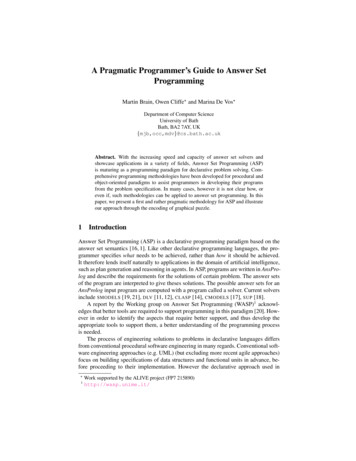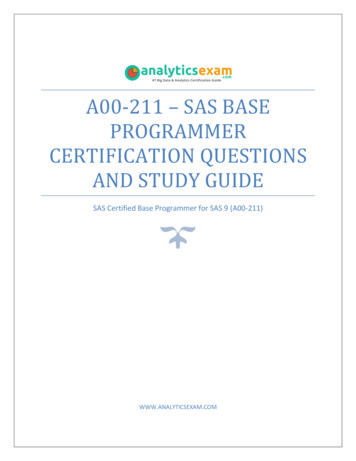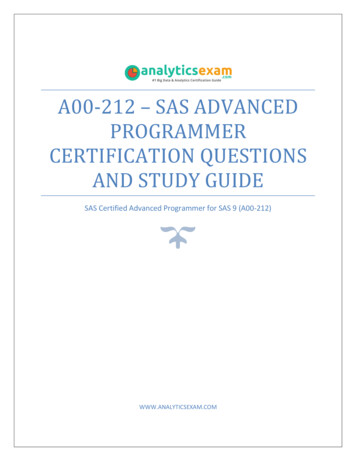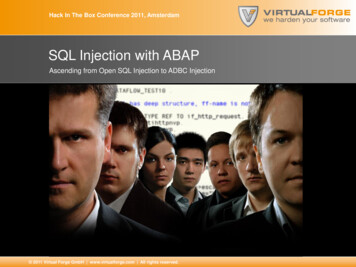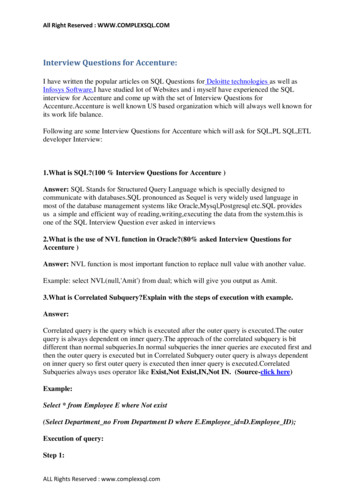
Transcription
Extracted from:SQL AntipatternsAvoiding the Pitfalls of Database ProgrammingThis PDF file contains pages extracted from SQL Antipatterns, published by thePragmatic Bookshelf. For more information or to purchase a paperback or PDFcopy, please visit http://www.pragprog.com.Note: This extract contains some colored text (particularly in code listing). Thisis available only in online versions of the books. The printed versions are blackand white. Pagination might vary between the online and printer versions; thecontent is otherwise identical.Copyright 2010 The Pragmatic Programmers, LLC.All rights reserved.No part of this publication may be reproduced, stored in a retrieval system, or transmitted,in any form, or by any means, electronic, mechanical, photocopying, recording, or otherwise,without the prior consent of the publisher.The Pragmatic BookshelfDallas, Texas Raleigh, North Carolina
SQL AntipatternsAvoiding the Pitfalls of Database ProgrammingBill KarwinThe Pragmatic BookshelfDallas, Texas Raleigh, North Carolina
Many of the designations used by manufacturers and sellers to distinguish their productsare claimed as trademarks. Where those designations appear in this book, and The PragmaticProgrammers, LLC was aware of a trademark claim, the designations have been printed ininitial capital letters or in all capitals. The Pragmatic Starter Kit, The Pragmatic Programmer,Pragmatic Programming, Pragmatic Bookshelf, PragProg and the linking g device are trademarks of The Pragmatic Programmers, LLC.Every precaution was taken in the preparation of this book. However, the publisher assumesno responsibility for errors or omissions, or for damages that may result from the use ofinformation (including program listings) contained herein.Our Pragmatic courses, workshops, and other products can help you and your team createbetter software and have more fun. For more information, as well as the latest Pragmatictitles, please visit us at http://pragprog.com.Copyright 2010 Bill Karwin.All rights reserved.No part of this publication may be reproduced, stored in a retrieval system, ortransmitted, in any form, or by any means, electronic, mechanical, photocopying,recording, or otherwise, without the prior consent of the publisher.Printed in the United States of America.ISBN-13: 978-1-934356-55-5Encoded using the finest acid-free high-entropy binary digits.Book version: P3.0—March 2012
Suppose you work as a software developer for a famous website for scienceand technology news.This is a modern website, so readers can contribute comments and even replyto each other, forming threads of discussion that branch and extend deeply.You choose a simple solution to track these reply chains: each comment references the comment to which it replies.Trees/intro/parent.sqlCREATE TABLE Comments (comment idSERIAL PRIMARY KEY,parent idBIGINT UNSIGNED,commentTEXT NOT NULL,FOREIGN KEY (parent id) REFERENCES Comments(comment id));It soon becomes clear, however, that it’s hard to retrieve a long chain of repliesin a single SQL query. You can get only the immediate children or perhapsjoin with the grandchildren, to a fixed depth. But the threads can have anunlimited depth. You would need to run many SQL queries to get all thecomments in a given thread.The other idea you have is to retrieve all the comments and assemble theminto tree data structures in application memory, using traditional tree algorithms you learned in school. But the publishers of the website have told youthat they publish dozens of articles every day, and each article can havehundreds of comments. Sorting through millions of comments every timesomeone views the website is impractical.There must be a better way to store the threads of comments so you canretrieve a whole discussion thread simply and efficiently.3.1Objective: Store and Query HierarchiesIt’s common for data to have recursive relationships. Data may be organizedin a treelike or hierarchical way. In a tree data structure, each entry is calleda node. A node may have a number of children and one parent. The top node,which has no parent, is called the root. The nodes at the bottom, which haveno children, are called leaves. The nodes in the middle are simply nonleafnodes.In the previous hierarchical data, you may need to query individual items,related subsets of the collection, or the whole collection. Examples of treeoriented data structures include the following: Click HERE to purchase this book now. discuss
6 Organizationchart:The relationship of employees to managers is the textbookexample of tree-structured data. It appears in countlessbooks and articles on SQL. In an organizational chart, eachemployee has a manager, who represents the employee’sparent in a tree structure. The manager is also an employee.Threadeddiscussion:As seen in the introduction, a tree structure may be used forthe chain of comments in reply to other comments. In thetree, the children of a comment node are its replies.In this chapter, we’ll use the threaded discussion example to show theantipattern and its solutions.3.2Antipattern: Always Depend on One’s ParentThe naive solution commonly shown in books and articles is to add a columnparent id. This column references another comment in the same table, and youcan create a foreign key constraint to enforce this relationship. The SQL todefine this table is shown next, and the entity-relationship diagram is shownin Figure 4, Adjacency list entity-relationship diagram, on page 7.Trees/anti/adjacency-list.sqlCREATE TABLE Comments (comment idSERIAL PRIMARY KEY,parent idBIGINT UNSIGNED,bug idBIGINT UNSIGNED NOT NULL,authorBIGINT UNSIGNED NOT NULL,comment date DATETIME NOT NULL,commentTEXT NOT NULL,FOREIGN KEY (parent id) REFERENCES Comments(comment id),FOREIGN KEY (bug id) REFERENCES Bugs(bug id),FOREIGN KEY (author) REFERENCES Accounts(account id));This design is called Adjacency List. It’s probably the most common designsoftware developers use to store hierarchical data. The following is somesample data to show a hierarchy of comments, and an illustration of the treeis shown in Figure 5, Threaded comments illustration, on page 8.comment idparent idauthorcomment1NULLFranWhat’s the cause of this bug?21OllieI think it’s a null pointer.32FranNo, I checked for that.41KuklaWe need to check for invalid input. Click HERE to purchase this book now. discuss
Antipattern: Always Depend on One’s Parent 7BugsCommentsFigure 4—Adjacency list entity-relationship diagramcomment idparent idauthorcomment54OllieYes, that’s a bug.64FranYes, please add a check.76KuklaThat fixed it.Querying a Tree with Adjacency ListAdjacency List can be an antipattern when it’s the default choice of so manydevelopers yet it fails to be a solution for one of the most common tasks youneed to do with a tree: query all descendants.You can retrieve a comment and its immediate children using a relativelysimple query:Trees/anti/parent.sqlSELECT c1.*, c2.*FROM Comments c1 LEFT OUTER JOIN Comments c2ON c2.parent id c1.comment id;However, this queries only two levels of the tree. One characteristic of a treeis that it can extend to any depth, so you need to be able to query thedescendents without regard to the number of levels. For example, you mayneed to compute the COUNT() of comments in the thread or the SUM() of the costof parts in a mechanical assembly.This kind of query is awkward when you use Adjacency List, because eachlevel of the tree corresponds to another join, and the number of joins in anSQL query must be fixed. The following query retrieves a tree of depth up tofour but cannot retrieve the tree beyond that depth:Trees/anti/ancestors.sqlSELECT c1.*, c2.*, c3.*, c4.* Click HERE to purchase this book now. discuss
8 Figure 5—Threaded comments illustrationFROM Comments c1LEFT OUTER JOIN Comments c2ON c2.parent id c1.comment idLEFT OUTER JOIN Comments c3ON c3.parent id c2.comment idLEFT OUTER JOIN Comments c4ON c4.parent id c3.comment id;-- 1st level-- 2nd level-- 3rd level-- 4th levelThis query is also awkward because it includes descendants from progressivelydeeper levels by adding more columns. This makes it hard to compute anaggregate such as COUNT().Another way to query a tree structure from Adjacency List is to retrieve allthe rows in the collection and instead reconstruct the hierarchy in the application before you can use it like a tree.Trees/anti/all-comments.sqlSELECT * FROM Comments WHERE bug id 1234;Copying a large volume of data from the database to the application beforeyou can analyze it is grossly inefficient. You might need only a subtree, notthe whole tree from its top. You might require only aggregate informationabout the data, such as the COUNT() of comments. Click HERE to purchase this book now. discuss
Antipattern: Always Depend on One’s Parent 9Maintaining a Tree with Adjacency ListAdmittedly, some operations are simple to accomplish with Adjacency List,such as adding a new leaf node:Trees/anti/insert.sqlINSERT INTO Comments (bug id, parent id, author, comment)VALUES (1234, 7, 'Kukla', 'Thanks!');Relocating a single node or a subtree is also easy:Trees/anti/update.sqlUPDATE Comments SET parent id 3 WHERE comment id 6;However, deleting a node from a tree is more complex. If you want to deletean entire subtree, you have to issue multiple queries to find all descendants.Then remove the descendants from the lowest level up to satisfy the foreignkey integrity.Trees/anti/delete-subtree.sqlSELECT comment id FROMSELECT comment id FROMSELECT comment id FROMSELECT comment id EWHEREparent idparent idparent idparent id 4;5;6;7;-----returnsreturnsreturnsreturns5 and 6none7noneDELETE FROM Comments WHERE comment id IN ( 7 );DELETE FROM Comments WHERE comment id IN ( 5, 6 );DELETE FROM Comments WHERE comment id 4;You can use a foreign key with the ON DELETE CASCADE modifier to automatethis, as long as you know you always want to delete the descendants insteadof promoting or relocating them.If you instead want to delete a nonleaf node and promote its children or movethem to another place in the tree, you first need to change the parent id ofchildren and then delete the desired node.Trees/anti/delete-non-leaf.sqlSELECT parent id FROM Comments WHERE comment id 6; -- returns 4UPDATE Comments SET parent id 4 WHERE parent id 6;DELETE FROM Comments WHERE comment id 6;These are examples of operations that require multiple steps when you usethe Adjacency List design. That’s a lot of code you have to write for tasks thata database should make simpler and more efficient. Click HERE to purchase this book now. discuss
103.3 How to Recognize the AntipatternIf you hear a question like the following, it’s a clue that the Naive Treesantipattern is being employed: “How many levels do we need to support in trees?”You’re struggling to get all descendants or all ancestors of a node, withoutusing a recursive query. You could compromise by supporting only treesof a limited depth, but the next natural question is, how deep is deepenough? “I dread having to touch the code that manages the tree data structures.”You’ve adopted one of the more sophisticated solutions of managinghierarchies, but you’re using the wrong one. Each technique makes sometasks easier, but usually at the cost of other tasks that become harder.You may have chosen a solution that isn’t the best choice for the way youneed to use hierarchies in your application. “I need to run a script periodically to clean up the orphaned rows in thetrees.”Your application creates disconnected nodes in the tree as it deletesnonleaf nodes. When you store complex data structures in a database,you need to keep the structure in a consistent, valid state after any change.You can use one of the solutions presented later in this chapter, alongwith triggers and cascading foreign key constraints, to store data structures that are resilient instead of fragile.3.4Legitimate Uses of the AntipatternThe Adjacency List design might be just fine to support the work you need todo in your application. The strength of the Adjacency List design is retrievingthe direct parent or child of a given node. It’s also easy to insert rows. If thoseoperations are all you need to do with your hierarchical data, then AdjacencyList can work well for you.Don’t Over-EngineerI wrote an inventory-tracking application for a computer data center. Some equipment wasinstalled inside computers; for example, a caching disk controller was installed in a rackmountserver, and extra memory modules were installed on the disk controller. Click HERE to purchase this book now. discuss
Legitimate Uses of the Antipattern 11I needed an SQL solution to track the usage of hierarchical collections easily. But I also neededto track each individual piece of equipment to produce accounting reports of equipment utilization, amortization, and return on investment.The manager said the collections could have subcollections, and thus the tree could in theorydescend to any depth. It took quite a few weeks to perfect the code for manipulating trees inthe database storage, user interface, administration, and reporting.In practice, however, the inventory application never needed to create a grouping of equipmentwith a tree deeper than a single parent-child relationship. If my client had acknowledged thatthis would be enough to model his inventory requirements, we could have saved a lot of work.Some brands of RDBMS support extensions to SQL to support hierarchiesstored in the Adjacency List format. The SQL-99 standard defines recursivequery syntax using the WITH keyword followed by a common table expression.Trees/legit/cte.sqlWITH CommentTree(comment id, bug id, parent id, author, comment, depth)AS (SELECT *, 0 AS depth FROM CommentsWHERE parent id IS NULLUNION ALLSELECT c.*, ct.depth 1 AS depth FROM CommentTree ctJOIN Comments c ON (ct.comment id c.parent id))SELECT * FROM CommentTree WHERE bug id 1234;Microsoft SQL Server 2005, Oracle 11g, IBM DB2, and PostgreSQL 8.4 supportrecursive queries using common table expressions, as shown earlier.MySQL, SQLite, and Informix are examples of database brands that don’tsupport this syntax yet. It’s the same for Oracle 10g, which is still widelyused. In the future, we might assume recursive query syntax will becomeavailable across all popular brands, and then using Adjacency List won’t beso limiting.Oracle 9i and 10g support the WITH clause, but not for recursive queries.Instead, there is proprietary syntax: START WITH and CONNECT BY PRIOR. You canuse this syntax to perform recursive queries:Trees/legit/connect-by.sqlSELECT * FROM CommentsSTART WITH comment id 9876CONNECT BY PRIOR parent id comment id; Click HERE to purchase this book now. discuss
Avoiding the Pitfalls of Database Programming This PDF file contains pages extracted from SQL Antipatterns, published by the Pragmatic Bookshelf. For more information or to purchase a paperback or PDF





